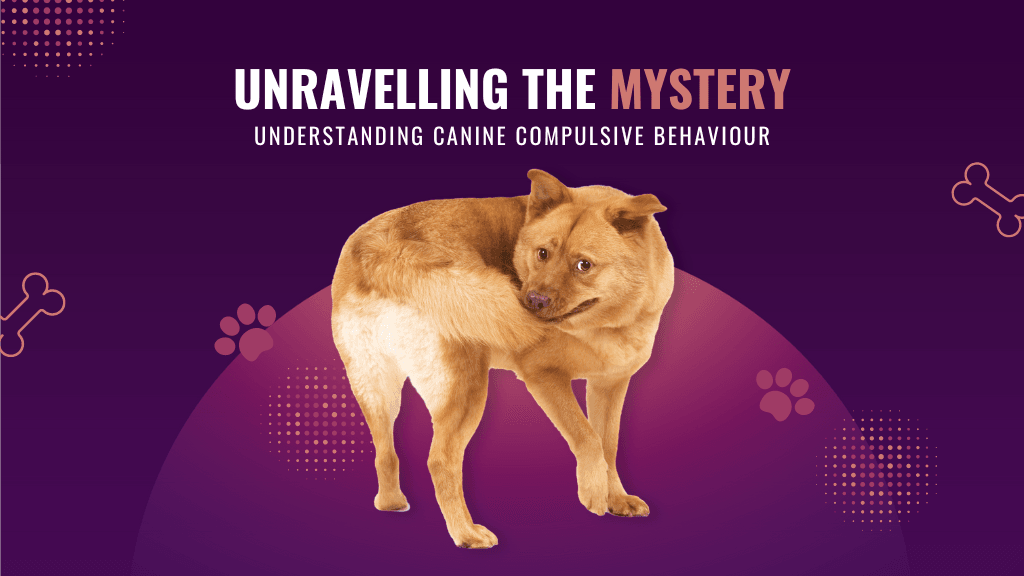Canine Compulsive Disorder: What You Need to Know About This Behavioural Condition
)
Dogs, much like humans, can develop compulsive behaviours that disrupt their daily lives. Canine Compulsive Disorder (CCD) is a condition where dogs repeatedly engage in obsessive actions, often to the point of self-harm. These behaviours can become so extreme that they negatively affect the dog’s health and overall quality of life. Though it may be difficult to determine if dogs experience obsessive thoughts, their actions provide clear signs of compulsive tendencies. Understanding the causes, symptoms, and treatments of CCD is vital for helping dogs live happy and healthy lives.
Dogs, much like humans, can develop compulsive behaviours that disrupt their daily lives. Canine Compulsive Disorder (CCD) is a condition where dogs repeatedly engage in obsessive actions, often to the point of self-harm. These behaviours can become so extreme that they negatively affect the dog’s health and overall quality of life. Though it may be difficult to determine if dogs experience obsessive thoughts, their actions provide clear signs of compulsive tendencies. Understanding the causes, symptoms, and treatments of CCD is vital for helping dogs live happy and healthy lives.
Recognising the Signs of Canine Compulsive Disorder
The symptoms of CCD may initially appear as typical behaviours seen in healthy dogs, such as tail chasing or licking. However, when these actions intensify and become repetitive, they could indicate a more serious issue. Some common signs of CCD include:
- Excessive licking or biting, leading to missing fur or raw skin, particularly around the tail and limbs.
- The behaviour becomes uncontrollable and persists even with intervention.
- Repeated tail chasing, sometimes resulting in injury to the tail.
- Compulsive behaviour that worsens over time and disrupts normal daily activities.
- Behaviour may have been triggered by a specific event, but often no clear cause is identified.
- Dogs with CCD may show decreased playfulness as their compulsive behaviour becomes more frequent.
These behaviours can escalate and cause significant harm, so it’s important to seek veterinary advice if you notice any of these signs.
Factors Contributing to Canine Compulsive Disorder
Several factors can trigger CCD in dogs, including physical pain, environmental changes, and genetics. Recognising these factors early can help manage the condition before it becomes severe.
- Pain: Chronic pain from injuries or other medical conditions can lead dogs to obsessively focus on certain areas of their bodies. Even after the initial issue is resolved, the compulsive behaviour may continue.
- Environmental Stress: Dogs are highly sensitive to changes in their surroundings. Stressful situations, disruptions in routine, or conflicts in the home can contribute to compulsive behaviours. Dogs may also develop anxiety when left alone for long periods, which can manifest as obsessive actions.
- Breed Predispositions: Some dog breeds are more prone to developing CCD than others. For instance, Dobermans often experience behaviours like flank sucking, while Cavalier King Charles Spaniels are known for fly snapping. Genetic research continues to explore the links between certain breeds and compulsive disorders.
Diagnosing and Managing Canine Compulsive Disorder
Diagnosing CCD involves ruling out other potential health issues, as some symptoms overlap with other conditions like allergies or neurological disorders. Your vet will conduct a full examination, including blood tests and imaging, to ensure the correct diagnosis.
Treatment typically involves a combination of physical activity, mental stimulation, and behaviour modification techniques:
- Physical Exercise: Regular exercise tailored to your dog’s breed and age can help manage energy levels and reduce the likelihood of compulsive behaviour.
- Mental Challenges: Introducing puzzle toys or games that engage your dog’s mind helps divert their attention from compulsive actions. Training exercises also provide mental stimulation and a sense of purpose.
- Distraction: When you notice compulsive behaviour starting, redirect your dog’s focus to a new activity. Avoid using food as a distraction to prevent reinforcing the behaviour.
- Medication: For severe cases, medications like antidepressants may be necessary to reduce the frequency of compulsive actions. These medications require ongoing administration and regular check-ins with your vet.
At North Road Veterinary Centre, we provide comprehensive care plans to help manage CCD. Our team will work with you to tailor a treatment plan that suits your dog’s needs, ensuring a happier, healthier future.
| Tags:DogClient InformationPet Behaviour |
&geometry(126x115))